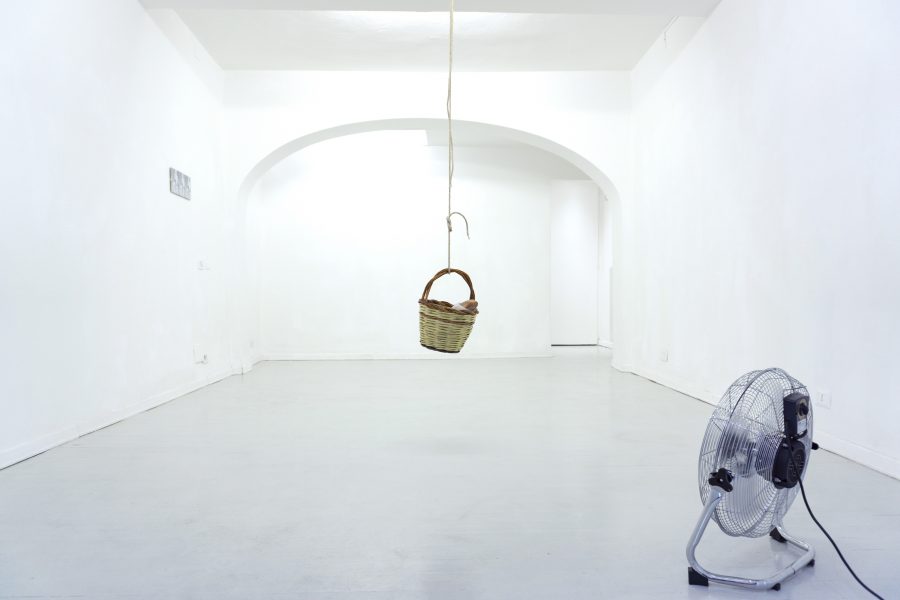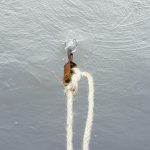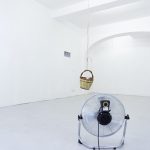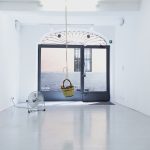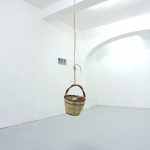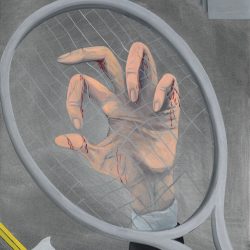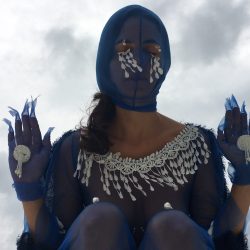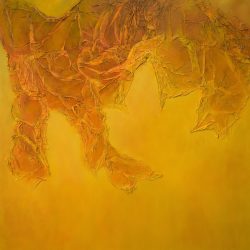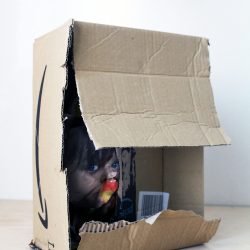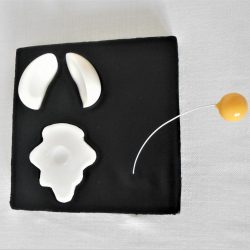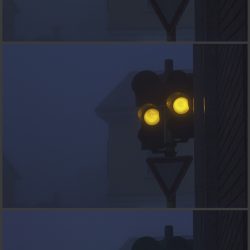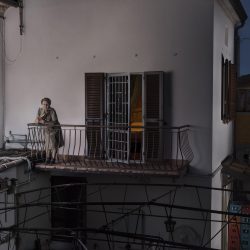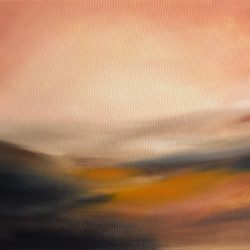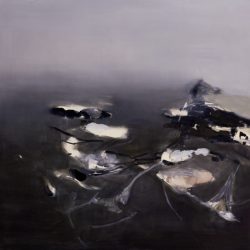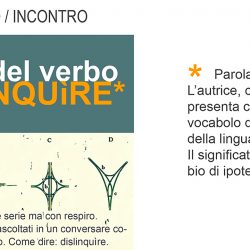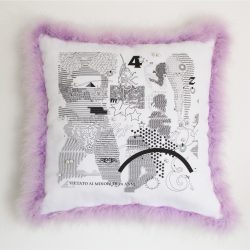work
è questo che sognavo da bambino? (part.II)
| category | Installation |
| subject | Travels, Political / Social, Landscape |
| tags | |
| base | 100 cm |
| height | 320 cm |
| depth | 100 cm |
| year | 2023 |
È questo che sognavo da bambino? (part II), 2023
Wicker basket, Sicilian bread, rope, fan
Dimensions variable
edition of 3
È questo che sognavo da bambino? (part II), 2023
Digital print on Fine Art paper, triptych
13 x 18 cm each
edition of 10 + 2AP
A basket slowly descends from the balcony of a house in response to the shout of a man or woman from below:
"Cala u panaru!" (“drop the basket off). Down comes and up goes the warm bread like a little miracle kept
safe in a wicker basket. Once there’s no bread left, everyone disappears, no hubbub from the
houses’courtyards, no clattering of pots and drawers from the kitchens. Only silence remains, and some crumbs
in the basket swaying for an airflow or a breeze from who knows where – moderate winds from the
northwestern quadrants, the Mistral, the Sirocco. Is this what you dreamed of as a child, Fabrice?
The image of the typical Sicilian panaru, crystallized by the artist in this second part of a wider project devoted
to recovering his Italian roots, is a nostalgic postcard of a journey back from Geneva to Catania. The basket
filled with bread and hanging in space evokes habits, rituals and necessities wich are still present in Southern
Italian and Mediterranean communities, weather as ordinary costumes or as tourist souvenirs. Through the
branches and fibers of a handmade basket, Fabrice Bernasconi traces the history of a traditional and ancient
craft such as that of the basketry and, with a few other elements - the bread produced in his homeland, a light
breeze – he evokes a clear geographic and anthropological dimension, he roots it out and then takes it with
him. The result is ironic and poetic at once: like if he was holding on to hazy memories of a dream, the artist
creates a synthetic vision that could retrace and reenact the experience lived. So, here those winds shaking
baskets and washing lines, blow from a simple fan. In this necessary dialogue between technology and
craftsmanship, the elements of the work screech, speaking two different languages. By recalling a folkloric
object and the symbols of a local culture, the work defiantly questions certain logics of gaze and its fascination
for an “elsewhere”. One comes back to his native place after years, and rediscover it by experiencing the dayto-day life, objects and gestures which had been forgotten. One travels to places unknow before with a hunger
to grasp its deepest truth, those things that only everyday life can reveal, fascinated by a foreign sense of
sacredness. Thus, the purely contemplative dimension of the work generates a feeling of displacement that
could find no better correspondence than these verses of Italian poet Giorgio Caproni, here translated (from
The wall of the Earth, 1975):
I have returned there
where I had never been.
Nothing has changed from what it wasn't.
On the table (on the checkered
waxed tablecloth) on the mezzanine
I once again found the glass
never filled. Everything
has stayed as
I had never left it.
By decontextualizing and defunctionalizing the symbol and its history, the artist therefore creates a residual
image: at the end of the day and the end of the dream, memories stay like leftovers or ghosts, together with the
lives of other and the slow time of repeated gestures that never change. And with these leftovers the artist
arranges an immediate and essential, yet articulate, symbolic system: the bread that no one has taken is the
earth and its grain, it is death, faith, superstition, nourishment and hunger, it is the succession of seasons, it is
sowing at the beginnings of culture and τέχνη, its deepest meaning of the hand that produces and puts into
practice what can be learnt from the world. Is this what you dreamed of as a child, Fabrice? There’s that too,
and that’s enough.
Ilaria Monti, 2023
Wicker basket, Sicilian bread, rope, fan
Dimensions variable
edition of 3
È questo che sognavo da bambino? (part II), 2023
Digital print on Fine Art paper, triptych
13 x 18 cm each
edition of 10 + 2AP
A basket slowly descends from the balcony of a house in response to the shout of a man or woman from below:
"Cala u panaru!" (“drop the basket off). Down comes and up goes the warm bread like a little miracle kept
safe in a wicker basket. Once there’s no bread left, everyone disappears, no hubbub from the
houses’courtyards, no clattering of pots and drawers from the kitchens. Only silence remains, and some crumbs
in the basket swaying for an airflow or a breeze from who knows where – moderate winds from the
northwestern quadrants, the Mistral, the Sirocco. Is this what you dreamed of as a child, Fabrice?
The image of the typical Sicilian panaru, crystallized by the artist in this second part of a wider project devoted
to recovering his Italian roots, is a nostalgic postcard of a journey back from Geneva to Catania. The basket
filled with bread and hanging in space evokes habits, rituals and necessities wich are still present in Southern
Italian and Mediterranean communities, weather as ordinary costumes or as tourist souvenirs. Through the
branches and fibers of a handmade basket, Fabrice Bernasconi traces the history of a traditional and ancient
craft such as that of the basketry and, with a few other elements - the bread produced in his homeland, a light
breeze – he evokes a clear geographic and anthropological dimension, he roots it out and then takes it with
him. The result is ironic and poetic at once: like if he was holding on to hazy memories of a dream, the artist
creates a synthetic vision that could retrace and reenact the experience lived. So, here those winds shaking
baskets and washing lines, blow from a simple fan. In this necessary dialogue between technology and
craftsmanship, the elements of the work screech, speaking two different languages. By recalling a folkloric
object and the symbols of a local culture, the work defiantly questions certain logics of gaze and its fascination
for an “elsewhere”. One comes back to his native place after years, and rediscover it by experiencing the dayto-day life, objects and gestures which had been forgotten. One travels to places unknow before with a hunger
to grasp its deepest truth, those things that only everyday life can reveal, fascinated by a foreign sense of
sacredness. Thus, the purely contemplative dimension of the work generates a feeling of displacement that
could find no better correspondence than these verses of Italian poet Giorgio Caproni, here translated (from
The wall of the Earth, 1975):
I have returned there
where I had never been.
Nothing has changed from what it wasn't.
On the table (on the checkered
waxed tablecloth) on the mezzanine
I once again found the glass
never filled. Everything
has stayed as
I had never left it.
By decontextualizing and defunctionalizing the symbol and its history, the artist therefore creates a residual
image: at the end of the day and the end of the dream, memories stay like leftovers or ghosts, together with the
lives of other and the slow time of repeated gestures that never change. And with these leftovers the artist
arranges an immediate and essential, yet articulate, symbolic system: the bread that no one has taken is the
earth and its grain, it is death, faith, superstition, nourishment and hunger, it is the succession of seasons, it is
sowing at the beginnings of culture and τέχνη, its deepest meaning of the hand that produces and puts into
practice what can be learnt from the world. Is this what you dreamed of as a child, Fabrice? There’s that too,
and that’s enough.
Ilaria Monti, 2023



